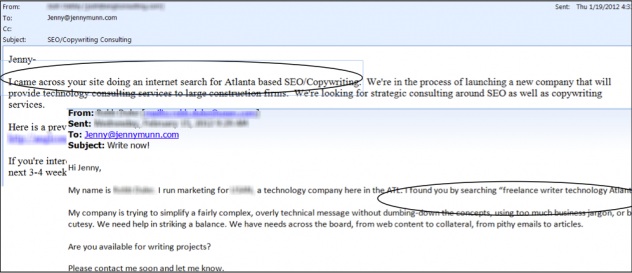Got an email recently from a budding copywriter with a big worry. She wrote:
What is the language of marketing? What kinds of jargon can I expect when I talk to marketing execs? I am concerned that in meetings or conference calls, I might find myself up against a foreign language of sorts because I never worked in a corporate marketing environment.
My first inclination was to simply say, “Not really a big issue in freelance copywriting. It’s not really like a different language, so don’t worry too much about it.â€
But then, I got to thinking about it and realized that, when you’ve been in the middle of a particular world for 20 years (this month, in fact…), it’s easy to imagine that it’s not all that complex. And bottom line, it really isn’t that terribly complex, but it’s not completely transparent, either.
And right about the time I got that question, I received an email from a new commercial freelancing client, with the background information on a new project he wanted me to quote. And in that email, he told me what files he’d attached, which included “the wires.†Commence head-scratching. Huh? Wires? What are the wires?
He was with a marketing/design firm, and after clicking through the source material, I realized that one of the documents was a line-drawing mockup of the website they’re creating for their client, and for which they need new copy. That six-page mockup with all the little boxes, arrows and greeking*—is known as the “wires.â€
*(Oh, that’s placeholder copy a designer inserts in spaces where copy is needed, but hasn’t been written yet. It usually reads, “Lorum ipsum dolor sit amet…†and a bunch of other, well, Latin, actually. So, the name’s a misnomer, but it’s still “greeking.†And two Latin-to-English translation sites are telling me that the five-word phrase above means…well, “Thong team…†Hmmmm. No clue. Remember, it’s placeholder copy.)
So, “wires.†Learn something new every day. So, maybe there’s a little more to the jargon in the commercial copywriting business than I’d like to believe. Of course, a couple of standard phrases come to mind: collateral, for instance: the term for various and sundry marketing communications pieces beyond ad copy that are part of a larger campaign—things like brochures, sales sheets, case studies, etc.
Then there’s the “creative brief.†Meaning, the document you’ll receive from clients (i.e., an agency, design firm, or the marketing department of the end-user themselves) describing the scope of the project in question, what the objective is, what the deliverables are (there’s another word: “deliverables,†meaning the final end products that need to be created, and which you’ve been entrusted to write), the timetable, contact people (a.k.a. “subject matter expertsâ€â€”a.k.a. SME’s, and yes, actually pronounced “Smee’s”—yet another term!), etc.
All that said, I still maintain that, even if you come from a background completely different from commercial writing, that it won’t be anywhere near the same as, say, visiting a foreign country where you don’t speak the language.
Over time, I learned all these (and many other) words by osmosis, but my overriding recollection is definitely not of one embarrassing moment after another as clients exchanged looks, loosely translated as, “Where did this guy come from?†Not so.
So, that’s a few that occurred to me off the top of my head, but I’m sure there are a ton of others I’m missing right now. So let’s help out this nervous newbie, and share some of the jargon you’ve come across in your freelance commercial writing travels.
And, for the record, I’m not talking about the silly jargon that’s the brunt of jokes about “corporate-speakâ€â€”things like mission-critical, value-added, at the end of the day, outside the box, leverage, etc.
Yes, our fledgling freelancer should familiarize herself with those as well (here’s a pretty good list), but I’m talking about the useful terms native to this field of ours.
What are some of the terms, phrases, jargon, that you’ve encountered in the course of your copywriting practice?
In your opinion, how hard is it for a newbie to get a handle on all the vernacular? Did you feel at all confused or out of your depth when you first started out in the business?
Are you aware of any resources/glossaries listing a lot of these terms (I know, I should know some…)?
Want to be a guest blogger on TWFW Blog? I welcome your contribution to the Well-Fed writing community! Check out the guidelines here.


